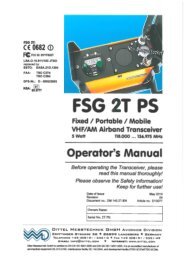EFIS-D6 Installation Guide
EFIS-D6 Installation Guide
EFIS-D6 Installation Guide
Create successful ePaper yourself
Turn your PDF publications into a flip-book with our unique Google optimized e-Paper software.
Appendix<br />
Heater Controller Wiring<br />
Before making the connections to your Heated<br />
AOA/Pitot Probe and controller, refer to the<br />
Recommended Wiring Practices section on page<br />
2-1. The chart at right provides general<br />
recommendations for wire gauge choice, given<br />
wiring run length.<br />
Probe to Controller Wiring<br />
As mentioned above, it is preferable that the<br />
heater controller box be mounted near enough to<br />
the probe that 5 wires between the controller and<br />
probe can be connected without extension. The<br />
Recommended wire gauge for runs,<br />
given 10-amp peak current<br />
Run length Gauge<br />
0’ – 7’ 18 AWG<br />
7’ – 9’ 16 AWG<br />
10’ – 16’ 14 AWG<br />
17’ – 24’ 12 AWG<br />
25’ – 40’ 10 AWG<br />
From FAA AC 43.13-1B, page 11-30<br />
three mating pairs of colored wires – terminated with Fastons – are used to carry the current to<br />
the heating element in the probe. The 2 white wires are for temperature measurement, and can<br />
thus be small. If you have mounted the heater controller near the probe and do not need to extend<br />
the wires between the two, simply plug each wire on the controller into its corresponding likecolored<br />
wire from the probe.<br />
If you do need to extend the wires between the probe and the controller, use the recommended<br />
wire size (see chart on page 5-8) for your run length. Since extending the wire runs requires that<br />
you cut the connectors off the 5 wires between the probe and controller, splice the extension<br />
wires between the probe and controller using butt splices or other similarly secure method. The<br />
white wires are not polarity-dependant. Additionally, as the white wires do not carry any<br />
significant current, you may extend them with 26 AWG or larger for any run length.<br />
Controller Power wiring<br />
Three wires – colored red, black, and white<br />
– exit the controller for connection to your<br />
electrical system. Power (between 10 and<br />
15 volts) is fed to the controller via the red<br />
and black wires. The maximum current<br />
draw of the heated pitot controller/probe is<br />
10 amps. You must route your own<br />
appropriately-sized wires to where the<br />
heater controller is mounted. Both power<br />
and ground lines should be able to handle<br />
10 amps with minimal voltage drop, as<br />
recommended in the chart on page 5-8.<br />
The red wire should be connected through<br />
a pilot-accessible switch to the main power<br />
source in the aircraft (limited to 15 volts).<br />
The switch allows you to manually turn the<br />
heater controller on and off, depending on<br />
the situation. Install a 15-amp fuse at any<br />
point along the power line to the heater<br />
Color<br />
Red<br />
Black<br />
White<br />
Notes<br />
Connected through a pilot-accessible<br />
switch to 10–15V supply. Must handle<br />
up to 10 amps.<br />
Must have a constant connection to<br />
ground. This is required for the warning<br />
light to operate when controller is<br />
powered off or not functioning. Line<br />
must handle up to 10 amps.<br />
Connected to a light bulb (or resistor &<br />
LED) tied to switched ship’s power.<br />
This line is grounded when the heater<br />
controller is powered off or not<br />
functioning. Connection can handle no<br />
more than 1 amp. Current depends on<br />
light source connected.<br />
5-10 <strong>EFIS</strong>-<strong>D6</strong> <strong>Installation</strong> <strong>Guide</strong>
















